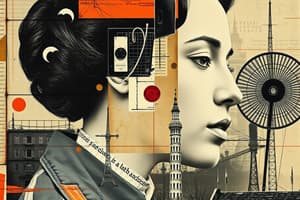Podcast
Questions and Answers
Какое искусственное движение было известно своим пропагандированием классовой прозы?
Какое искусственное движение было известно своим пропагандированием классовой прозы?
- Проза из перспективы животных
- Реализм (correct)
- Романтическая проза
- Звериная точка зрения
Что такое химерическая проза?
Что такое химерическая проза?
- Использование звериной перспективы в повествовании
- Смешение реализма с поэтической структурой
- Смешение научной фантастики с фэнтези (correct)
- Сочетание романтических и детективных сюжетов
Что объединяет жанр роман-баллада?
Что объединяет жанр роман-баллада?
- Использование звериной перспективы в повествовании
- Романтические произведения о животных
- Литературный реализм с поэтической структурой (correct)
- Фэнтези с научной фантастикой
Какова основная цель социалистического реализма?
Какова основная цель социалистического реализма?
Что является характерной чертой химерической прозы?
Что является характерной чертой химерической прозы?
Что объединяет новеллу-балладу?
Что объединяет новеллу-балладу?
Какие черты характерны для романтической прозы?
Какие черты характерны для романтической прозы?
Что демонстрирует химерическая проза в романе 'Blindsight' Питера Уоттса?
Что демонстрирует химерическая проза в романе 'Blindsight' Питера Уоттса?
Какую цель преследовал Джон Стейнбек, создавая роман 'The Grapes of Wrath'?
Какую цель преследовал Джон Стейнбек, создавая роман 'The Grapes of Wrath'?
Что стремился вызвать автор Джон Стейнбек у своих читателей?
Что стремился вызвать автор Джон Стейнбек у своих читателей?
Study Notes
Literature: An Overview
Literature is an expansive field with a diverse range of genres, forms, and styles. From ancient mythologies to contemporary novels, literature encompasses various artistic expressions that reflect societal norms, cultural values, historical events, and personal experiences. This section will briefly cover some notable literary movements and narrative techniques before delving into specific examples.
Literary Movements
Socialist Realism
Socialist realism was a political movement known for its promotion of proletarian class fiction. In this genre, authors often depicted life stories from the perspective of working people rather than capitalists or aristocrats. This shift in focus was intended to inspire solidarity among the working class through shared narratives. The Soviet Union became particularly associated with socialist realism due to their support for this type of writing during the Stalinist era.
Chimera Prose
Chimerical prose refers to a narrative technique where different genres or elements are combined within one text, creating unique and hybridized works. These hybrids may blend science fiction with fantasy, romance with detective storylines, or any other combination deemed creatively engaging by the author. This approach allows writers to experiment with new ways of storytelling while captivating readers with unexpected twists.
Novel-Ballad
The novel-ballad genre combines literary realism with poetic structure. This fusion results in longer poems, typically containing a series of linked stanzas that develop a plot and characterization similar to those found in traditional novels. By merging these two distinct formats, novel-ballads offer an immersive reading experience that combines the narrative depth of a novel with the rhythmic beauty of poetry.
Romantic Prose
Romantic prose emerged alongside romanticism, an influential literary and artistic movement spanning roughly from 1800 to 1850. Characteristic features of romantic prose include heightened emotions conveyed through vivid descriptions, intricate symbolism, and often ambiguous endings that invite interpretation. Many romantically inclined authors sought to evoke powerful feelings within their readers, encouraging them to appreciate the world around them more deeply.
Subtopic Examples
Socialist Realism Example: "The Grapes of Wrath" by John Steinbeck
John Steinbeck's Pulitzer Prize-winning novel, "The Grapes of Wrath," exemplifies socialist realism with its portrayal of hardships faced by migrant workers during the Great Depression in America. Through compelling narratives centered around individuals belonging to the working class, Steinbeck aimed to raise awareness about economic inequality and promote empathy among his audience.
Chimera Prose Example: "Blindsight" by Peter Watts
Peter Watts' science fiction thriller, "Blindsight," demonstrates chimera prose through its seamless blending of physics, psychology, and philosophy. The novel's plot revolves around human crew members and an alien intelligence on a mission towards Jupiter. By combining elements from various genres, Watts creates a captivating narrative that challenges readers' perceptions of consciousness and reality.
Novel-Ballad Example: "The Sailor's Story" by Emily Dickinson
Emily Dickinson's poem "The Sailor's Story" showcases the novel-ballad genre with its interconnected stanzas that tell a narrative about a sailor's experiences at sea. The rhythmic structure provides a sense of continuity throughout the poem, allowing Dickinson to explore themes such as mortality and the transience of life.
Romantic Prose Example: "Wuthering Heights" by Emily Brontë
Emily Brontë's classic novel "Wuthering Heights" epitomizes romantic prose with its intense emotionality, complex characters, and atmospheric settings. Set in Northern England, the story revolves around the tumultuous relationship between Catherine Earnshaw and Heathcliff, illustrating themes like love, revenge, and vengeance.
Studying That Suits You
Use AI to generate personalized quizzes and flashcards to suit your learning preferences.
Description
Explore various literary movements like Socialist Realism, Chimera Prose, Novel-Ballad, and Romantic Prose, along with their unique narrative techniques and characteristics. Learn how these movements have influenced the development of literature and storytelling throughout history.




